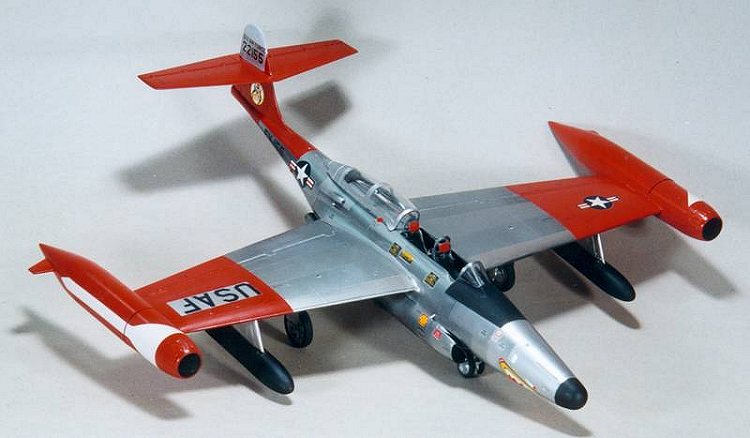
|
KIT: |
Revell 1/48 F-89 Scorpion |
|
KIT # |
4548 |
|
PRICE: |
@25.00 |
|
DECALS: |
See review |
|
REVIEW & |
|
|
NOTES: |
|

|
HISTORY |
Just after World War II, the United States found themselves facing a new enemy : the Soviet Union. This country, with its carbon copy of the B-29, had an aircraft able of striking North America and was busy developing long range bombers which could strike the US. American Chiefs of Staff found that very idea quite unpalatable and asked for a long range all weather interceptor carrying enough firepower as to bring any marauding Soviet bomber down.
Curtiss proposed the XP-87 Blackhawk, a four engined, two seater aircraft. Douglas answered with a land based version of the F3D Skyknight which was to equip the US Marine Corps. Northrop, designer of one of the best nightfighters during WW II with the P-61 Black Widow, proposed the XP-89 Scorpion. Air Force evaluators ranked the Scorpion last, but declared it had the best potential for evolution, and gave Northrop the contract, thus ending Curtiss activities. The Air Force had a winner, but how did this winner look?
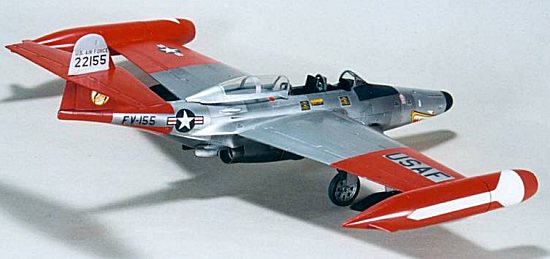 Well, if you think an interceptor is a sleek and elegant aircraft, you are
very accurately describing almost everything but a Scorpion. This aircraft is
big, with a 60 ft span without tip tanks Ėit had to carry a huge amount of
fuel to stay aloft above the Arctic wastes in these days before in-flight refueling.
It had an endless nose, necessary to house the fire control system.
Well, if you think an interceptor is a sleek and elegant aircraft, you are
very accurately describing almost everything but a Scorpion. This aircraft is
big, with a 60 ft span without tip tanks Ėit had to carry a huge amount of
fuel to stay aloft above the Arctic wastes in these days before in-flight refueling.
It had an endless nose, necessary to house the fire control system.
The first versions (F-89 A, B and C) had six 20mm cannons in the nose. Behind them, the two man crew was seated in a tandem configuration, pilot and radar operator. The wings were huge, and in a mid-fuselage position. Two Allison J-35 turbojets were slung under the fuselage. They were soon fitted with afterburner as their dry thrust was deemed insufficient. The low intakes turned the engines into splendid FOD detectors. The tail assembly was classical, but sat very high above the ground because of the short nose gear leg. This tail high attitude gave the aircraft its name.
As the atomic bomb became the main instrument in East/West confrontation, the Air Force thinkers changed their perspective. It became totally unbearable to let a single bomber pass through the defense lines, and the cannons were seen as lacking punch. This gave birth to the F-89 D, with a rocket only armament. On each wing tip was an enormous fuel tank, with housing for fifty two 70mm air to air rockets at the front. The 104 rockets could be fired in one, two or three salvoes, and each of them could ruin the day of a bomber.
E, F and G variants never left the drawing board. The last produced variant was the F-89 H. Its wingtip pods housed three Falcon missiles and 24 rockets each.
Three hundred and fifty F-89 D were rebuilt as F-89 J? The wing tip tanks were plain fuel tanks, but four Falcon air to air missiles were hung under the wings, as well as two Genie air to air, nuclear tipped unguided rockets. One could call that poetry in motion.
|
THE KIT |
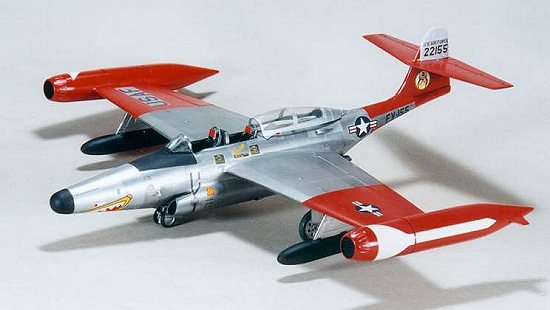 Revell released this model ten years ago. The box is big, and its cover shows
a F-89 D sporting a gaudy shark mouth and arctic red markings.
Revell released this model ten years ago. The box is big, and its cover shows
a F-89 D sporting a gaudy shark mouth and arctic red markings.
The parts are moulded in a tough, metallic gray styrene. The panel lines are accurate and thin, but raised. The Revell logo is raised, too, and is a sandpaper magnet. There are parts for a D and a J model, with parts specific to each of these variants, such as wing tip tanks or rocket pods, underwing tankls or armament and different instrument panels. The main mistake in the kit is the rocket pods, where the rocket warheads protrude where they shouldnít.
The decals offer a F-89 D from the 61st TFW based in New Foundland in 1958 and a F-89 J from Iowa Air National Guard.
If ever you choose building athis J model, donít forget that, according to the Detail & Scale book, ANG units werenít issued with Falcons.
|
CONSTRUCTION |
I began with an attack of enthusiasm that should have deserved me a straight jacket; I decided to re-scribe ALL the panel lines, and as it was the first time I attempted such a feat, it was an entertaining exercise in self-control. Help from friends, a sewing needle held in a suitable handle and 6mm DYMO tape allowed me to survive this ordeal relatively undamaged.
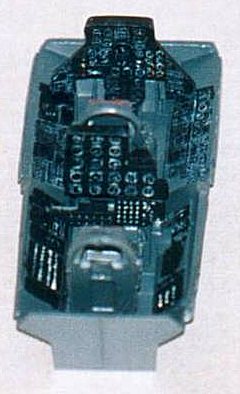 Once all the scribing, sanding, and general mess cleaning up was done, I
began with the cockpit. Detail there is rather good, with raised instrument
details and consoles.
Once all the scribing, sanding, and general mess cleaning up was done, I
began with the cockpit. Detail there is rather good, with raised instrument
details and consoles.
I painted the instrument panels black and drybrushed them with white. I put some color dabs here and there, according to the color pictures I found in the D&S book, which show a J interior, I know. All the dials got a drop of Humbrol Clearfix. The tub was then painted dark gray, and I realized it was exactly the wrong gray too late to fix anything. The details were painted black and drybrushed white.
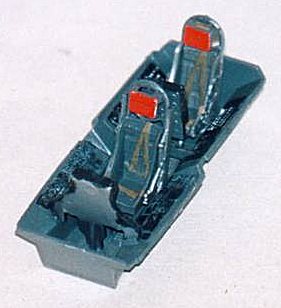 I added the lap belts to the seats using lead foil. The seats were painted
gray, the head rests gloss red and the belts olive drab with silver buckles. I
drilled out all the holes on the foot rest of the back seat.
I added the lap belts to the seats using lead foil. The seats were painted
gray, the head rests gloss red and the belts olive drab with silver buckles. I
drilled out all the holes on the foot rest of the back seat.
I put two .44 lead balls in the nose, and tried to put the fuselage halves together. Trouble is, they didnít want to stay that way. I think one of them suffered when it was removed from the mold, as it was more oddly shaped than any self-respecting F-89 fuselage half should be. I glued the fuselage halves at the nose, held the rest in place with strong adhesive tape, and worked my way to the tail brushing liquid cement on the interior joint.
The cockpit tub was inserted without fuss, but needed a rear bulkhead to hide
the fuselage interior. I sprayed Gunze gloss black on the turbine blades, let it
cure, then sprayed Alclad II Highly Polished Aluminum. I inserted that part in
the fuselage. The belly 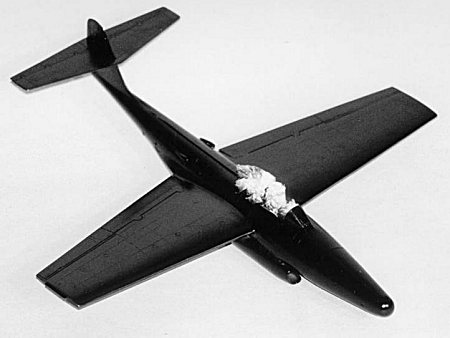 plate was rather reluctant to get where it should,
because of the warping on the fuselage. Some persuasion, lots of putty and a thorough
sanding solved the problem.
plate was rather reluctant to get where it should,
because of the warping on the fuselage. Some persuasion, lots of putty and a thorough
sanding solved the problem.
I drilled holes under the wings for the underwing tanks, and assembled the wings, gluing the main undercarriage doors close in the meantime. Wing to fuselage fit was poor, for the same reason, and it was putty time again.
The radome didnít fit well either, and the puttying and sanding were delicate to keep the nose shape right. The intakes needed less putty, as did the air scoops above the fuselage. The tailplane and fintip went into place without problem.
I masked the windscreen using Tamiya tape, then glued it in place, puttied the joint lines and sanded the place to get as smooth a finish as possible.
A coat of acrylic light gray was sprayed to detect all the rough spots, which were sanded away. After a good amount of buffing, the Scorpion was ready for the paint shop.
|
PAINT & DECALS |
Painting
I had decided to give Alclad II paints a try, so I first sprayed the interior color on the windscreen, followed with a coat of Gunze gloss black, which I let cure a week.
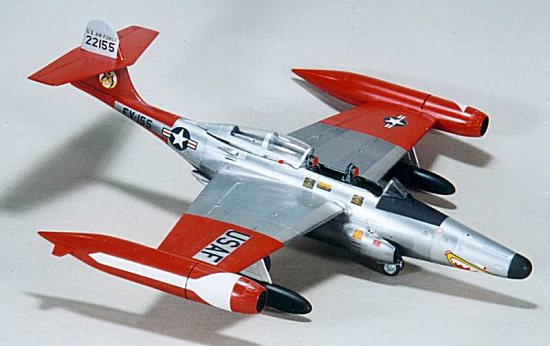 I sprayed two coats of Aluminum at a ten minute interval. The next day, I
masked some panels then sprayed a coat of Duraluminium. The leading edges
received a coat of Highly Polished Aluminum. Finally, two panels on the spine
were painted Testors Metallizer Aluminum, while the nose sides received the
whole SnJ treatment, paint then powder.
I sprayed two coats of Aluminum at a ten minute interval. The next day, I
masked some panels then sprayed a coat of Duraluminium. The leading edges
received a coat of Highly Polished Aluminum. Finally, two panels on the spine
were painted Testors Metallizer Aluminum, while the nose sides received the
whole SnJ treatment, paint then powder.
I removed the masks, then gasped : even such a low tack tape as drafting tape had pulled some Aluminium chips away! Some sanding with worn out sandpaper followed by another coat in the touched spots hid hte damage.
Chastised, I let the paint cure for a whole week before masking for the Arctic markings, which werenít Arctic Red but Insignia Red. I used Humbrol Gloss Red #19 for them. I painted the radome and anti glare panel flat black and the fin tip white.
Finishing
I painted the landing gear doors interior Testorís Metalizer Aluminum, and the outside received SnJ. The gear legs, gear actuators and wheels were painted aluminum, and the tires Aeromaster Tire Black.
The underwing tanks received a flat black coat and their pylons were painted Aluminum. The wing tip pods were painted Gloss Red.
When everything was dry, I glued all the bits that protrude and break on handling.
I used the kit decals, and chose the gaudy shark mout markings. The decals went on without a glitch, but, as they were flat, needed a gloss coat.
Out of sheer laziness, I decided not to weather my Scorpion.
|
CONCLUSIONS |
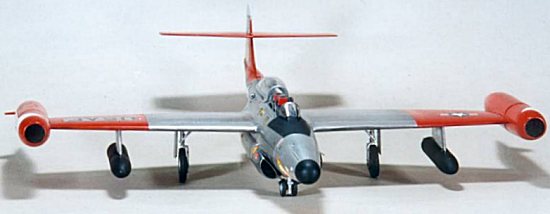 This is an aircraft that, even if not exactly good looking, attracts the eye.
I donít think the model is difficult, just that my sample had problems that
made me live interesting times.
This is an aircraft that, even if not exactly good looking, attracts the eye.
I donít think the model is difficult, just that my sample had problems that
made me live interesting times.
I tried a lot of things for the first time on it : Alclad II paints, NMF, and scribing.
I freely admit my scribing is rather far from Tamigawaís, but the general result did please me.
Anyway, Iíll wait some time.
If you would like your product reviewed fairly and quickly by a site that has over 1,500 visits a day, please contact me or see other details in the Note to Contributors.